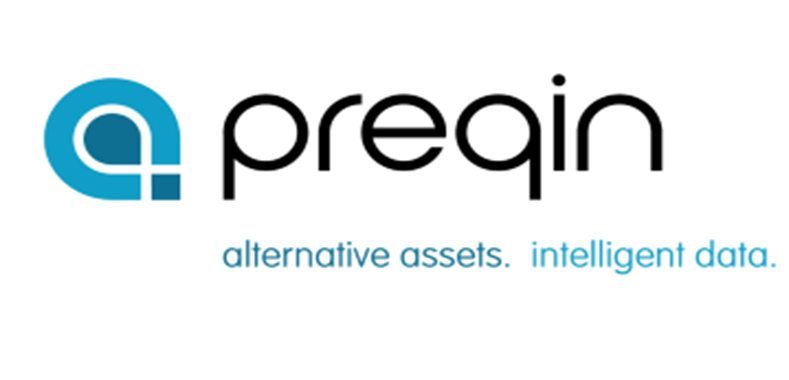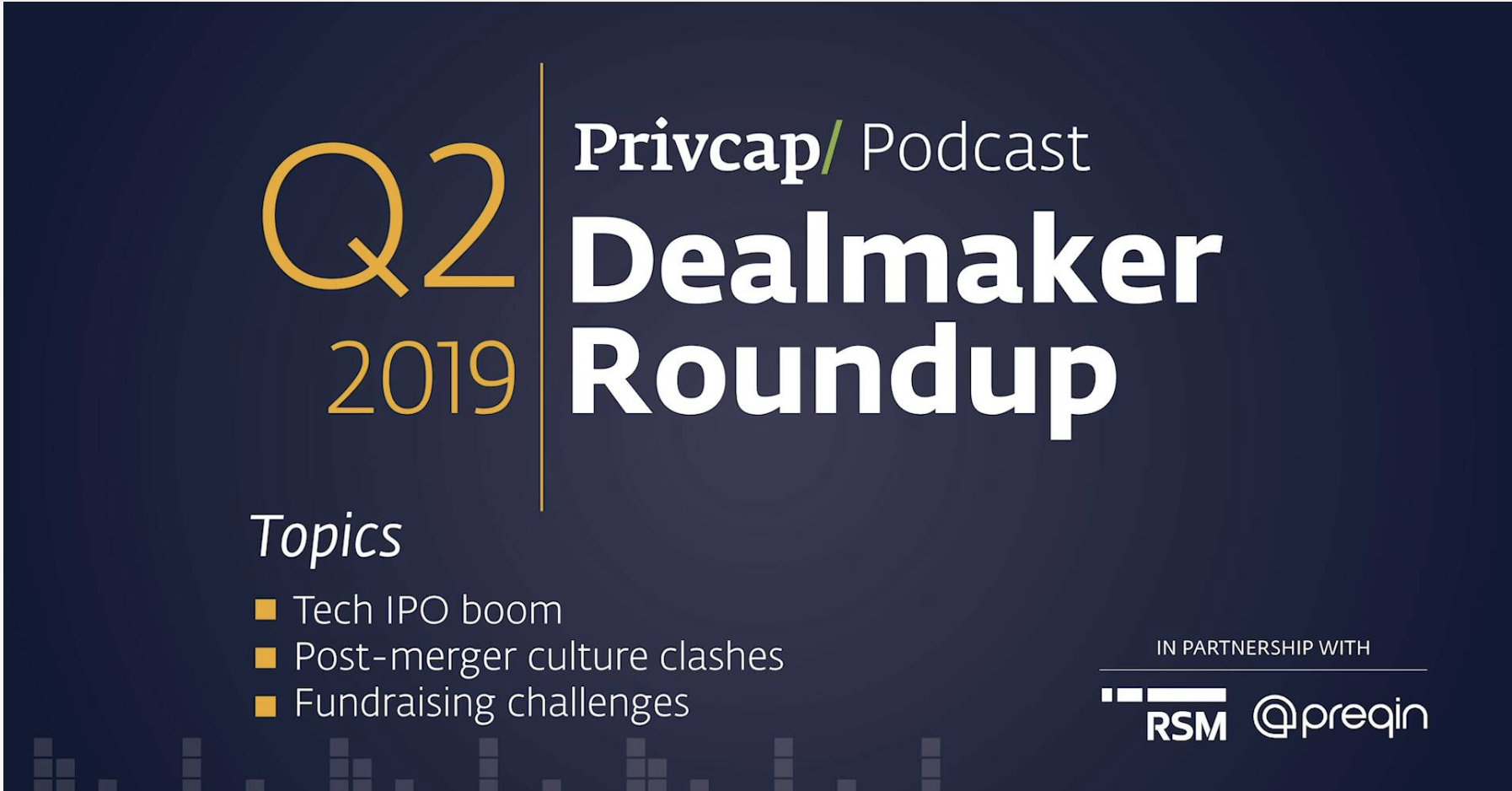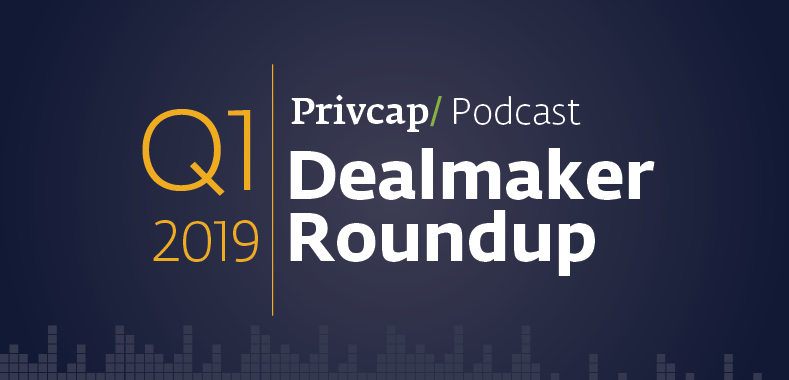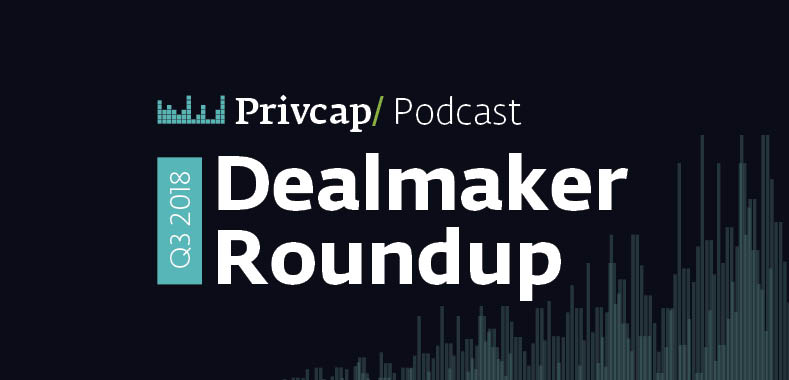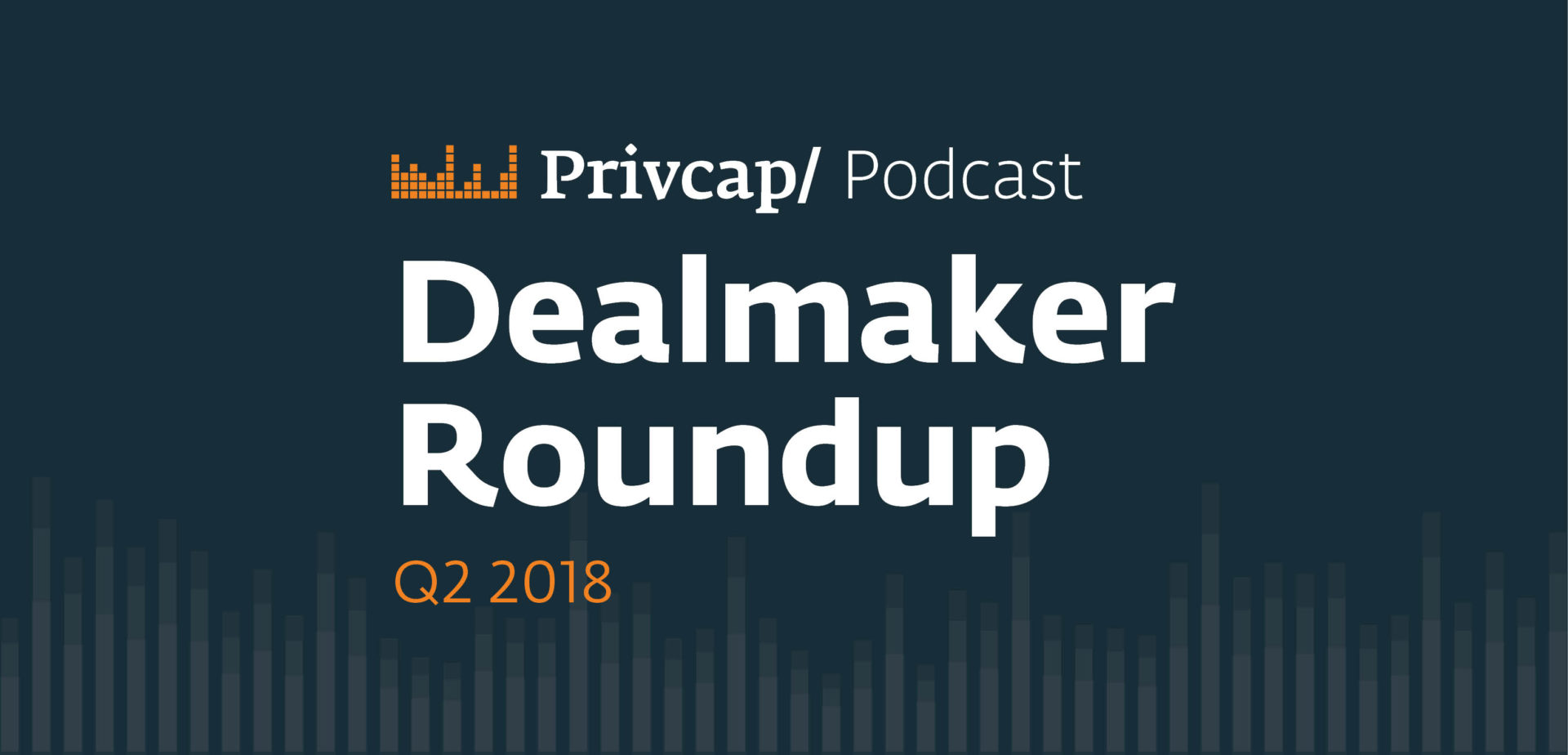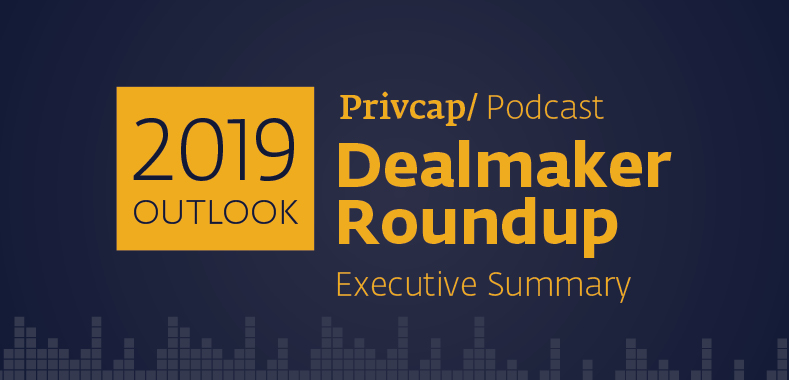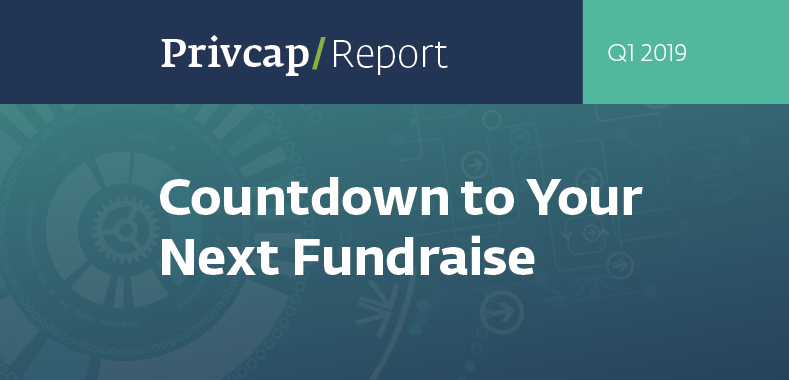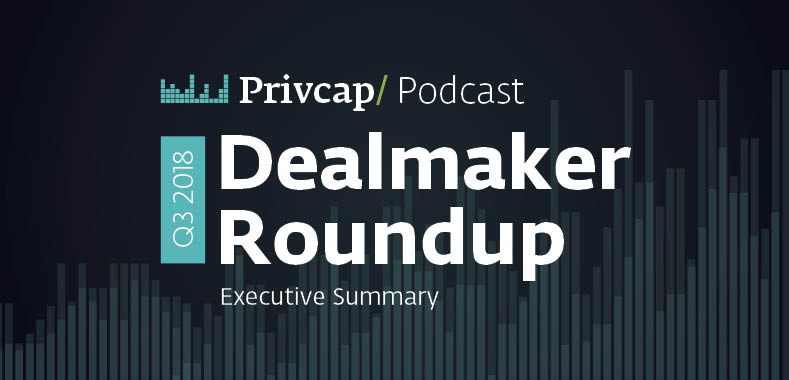Dealmaker Roundup: 2019 Outlook
A panel of PE deal experts from Harris Williams, Preqin and RSM explain why they remain optimistic about the deal market in 2019.
Transcript Download Transcript
Dealmaker Roundup: 2019 Outlook
David Snow, Privcap: Jesse, why don’t we start by you giving us a tour through the most interesting private equity deal highlights of 2018?
Jesse Fahy, Preqin: What really stood out for me in 2018 in the deal space was just how remarkably consistent and well-rounded it was really from year start to year end. We had the new record high for total number of deals globally, but we also are most likely going to have the highest number for aggregate deal value, post-recession, once it’s all said and done. We’re still collecting a few straggler deals from the end of the year. But there is a good chance that will surpass the 2013 high. We weren’t seeing capital flow into any one industry in particular. We saw 15% going into tech, 14% invested industrials, 30% in healthcare, and 12% business services as well as telecom, media, and communications. The hot deals in tech are perhaps starting to slow down just a bit.
Snow: What are managers saying about their interest in doing deals in 2019?
Fahy: Preqin does a survey towards the end of every year to get the temperature of the market from both GPs and LPs. In the most recent survey, 64% of GPs said they actually want to put more capital to work in 2019 than they did in 2018. And there’s certainly the money for it. There’s very high dry powder in the industry right now—I think we’re at $1.2 trillion.
Snow: Michael Hogan, what did Harris Williams’ 2018 look like and what’s your take on this record level of M&A activity?
Michael Hogan, Harris Williams: We, we as an advisor, had a record year. This was supported by a key factor: Obviously there is a very strong underlying economy, low unemployment, strong growth, and while there are geopolitical clouds on the horizon and have been for the last couple of years, that really didn’t seem to have had much of an impact across a broad swath of the U.S. economy. Even things like the trade tariff and battles with China really have had marginal impact and only in select sectors.
Snow: What specifically were private equity firms up to last year?
Hogan: Private equity groups accounted for the highest percentage of overall M&A activity. Around 35% of all deals were acquired by private equity. Then there are all the small deals done by entrepreneurs, and private equity has even a greater share than that.
Snow: Michael Fanelli, as an advisor to many private equity clients doing deals in the market, what was your 2018 like?
Michael Fanelli, RSM: 2018 was another record year for the RSM transaction team. We had our best calendar year in terms of overall activity, both from a size perspective and from a volume perspective, both buy-side and sell-side due diligence. Since we are the largest middle market due diligence practice, we saw a wide range of deal sizes. We saw a tremendous amount of public company carve-outs in addition to your typical private company LBOs done by private equity firms, and a ton of add-on acquisitions.
Snow: A quick follow-up question for Michael Hogan from Harris Williams: The value of private equity deals in 2018 would have been at an all-time high had it not been for the dearth of mega-deals seen in spades leading up to 2008. Why do you think more very large private equity deals are not getting done?
Hogan: Because of a combination of a couple of factors. One is, there were a handful of very, very large deals that skewed the totals at the market peak in the pre-recession. Some of those deals didn’t turn out all that well. I think there has been a backing away from those sorts of bet-the-farm kind of deals. The average size of equity size check being written today is smaller and there’s a broader range of deal sizes [among the mega-firms]. In addition, if you look at public valuations, those targets trade at such a level that it’s just a little too rich for them to be taken private.
Fanelli: This is due to the success of private equity compared not only to the public markets but to other alternative asset classes. Private equity has become a consistent place where LPs put money, which is adding to the total amount allocated to private equity over time.
Hogan: To the question of are there too many groups chasing too few deals, you could argue, no doubt, that the market has become incredibly efficient and much more competitive. That said, we track the number of total portfolio companies. In 2000, that number was roughly 1,750. Today, that number is over 8,000. So certainly the breadth of activity has kept up with the number of new funds coming into the market.
Fahy: Part of what is driving this growth is Asia. We’re seeing the creation of domestic PE shops across China and Southeast Asia.
Snow: 2018 was not at all a record year for fundraising. In fact, we saw a steep drop in both the number of funds that got raised and the total amount that was raised. At the same time, more GPs than ever trying to raise capital. Jesse also mentioned a poll that had GPs eager to invest even more in 2019. Is there a disconnect between LP caution and GP bullishness?
Hogan: I’m not sure it’s the case that LPs are more conservative. Look, there’s a natural bias in the industry. If you’re a fund, you get paid to invest. There’s always going to be a level of optimism bullishness that is more prevalent on the GP side than the LP side. That’s just the nature of the business and who’s attracted to doing private equity. I think it’s just a function of timing and amount of dry powder that’s still available. In addition, we know of some very big funds that are out fundraising currently.
Fahy: 2018 was a little bit of misnomer. Yes, compared to 2017, 2016, it looks a little bit weak. However, we’ve had five very strong years now of over $400 billion raised per year. We are still in a strong cycle. In our survey, we asked fund managers about how they see investor appetite, and they said that they actually saw increased investor appetite.
Snow: Michael Fanelli, it seems like very few people in the GP community think that there’s a recession around the corner, right? Otherwise, they would be selling everything that’s not nailed down to the floor…
Fanelli: In every investment, the private equity firm has an investment thesis and strategy. If they haven’t executed on that strategy, they’re not selling it yet. They’re not putting it into the market. They’re not putting that portfolio company into the market yet. It is not a case of them thinking a recession is looming and therefore they’re going to sell everything in their portfolio. I think they want to get the right ROI. The GPs really need to invest in all cycles.
Hogan: I do think everybody views this as a very strong seller’s market, and to the degree they’ve got an investment that is near ready to exit, they are seriously contemplating that in the current year.
Snow: Michael Hogan, what can you tell us about the state of the debt market for private equity deals? How available is financing?
Hogan: Not dissimilar to the M&A cycle or the general economic recovery, we are long in the tooth of a very strong leverage loan market cycle. The debt market had a very good year, with record volume, and CLO formations saw a record. We had what was arguably some of the best conditions ever as a seller to issue debt. By any parameter you want to mention, it was probably the best debt market we’ve seen in the last 30 years. The leverage markets were extremely challenging at the end of last year, but we have been pleasantly surprised that market activity is good again.
Fanelli: Speed to close a deal in the private equity world is at a premium. If you can get your diligence done faster than your competitor, if you can line up financing faster than your competitor, you’re going to have a leg up on anyone else to win that deal and to ultimately close that deal. Also important is that you’re getting the right terms, the right rates, the right covenant situations on your loan so that you have a well thought out, profitable financing of that deal throughout your ownership period.
Snow: Any final thoughts on what lies ahead for 2019?
Hogan: Nobody has a crystal ball, but our view is that there’s a greater likelihood that we’re going to hit a speed bump here than in prior years just because we are 10 years into this recovery. But that said, with the combination of strong underlying economy, abundant capital to put to use, great debt market conditions, everything we see points to another very strong year in the M&A markets and sponsor activity.




